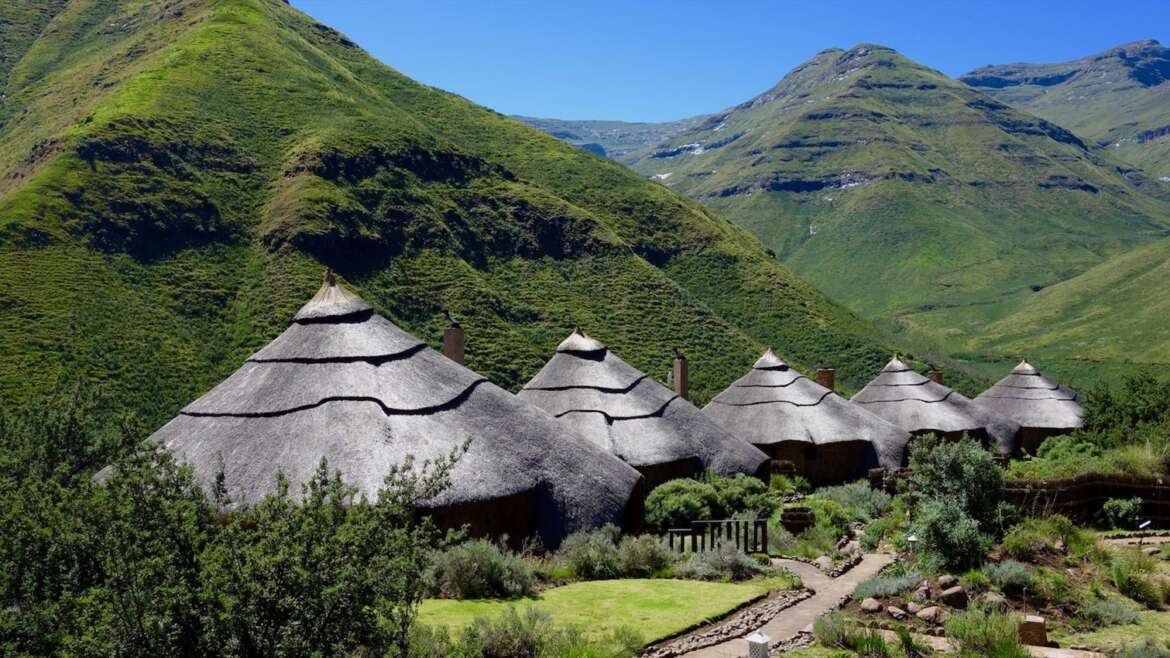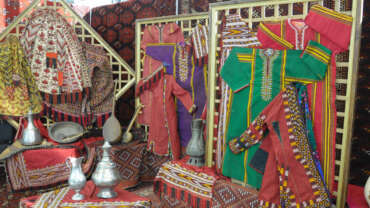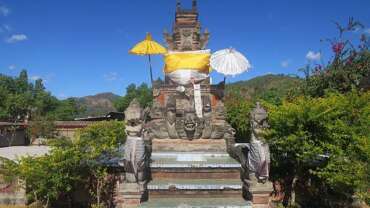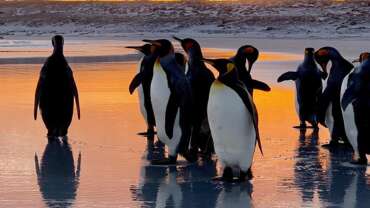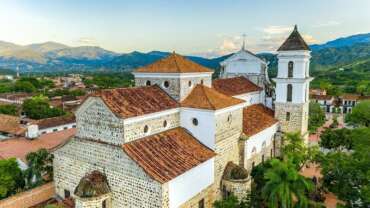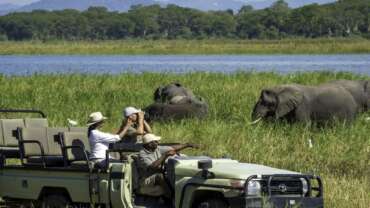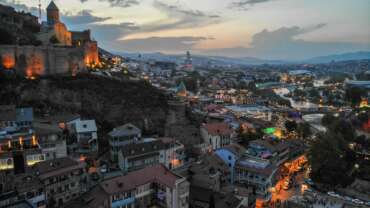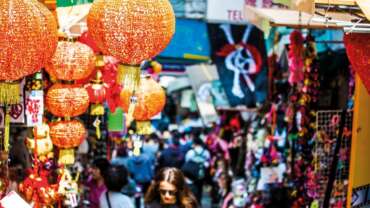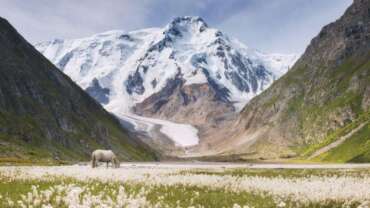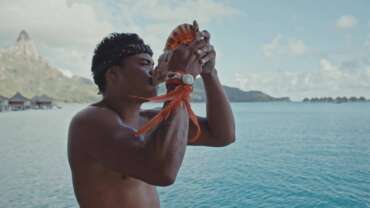Lesotho - The Kingdom in the Sky
Lesotho, a high-altitude, landlocked kingdom encircled by South Africa, is crisscrossed by a network of rivers and mountain ranges including the 3,482m-high peak of Thabana Ntlenyana. On the Thaba Bosiu plateau, near Lesotho’s capital, Maseru, are ruins dating from the 19th-century reign of King Moshoeshoe I. Thaba Bosiu overlooks iconic Mount Qiloane, an enduring symbol of the nation’s Basotho people.
The Kingdom of Lesotho is a sovereign democracy surrounded by South Africa on all sides. It is a relatively small and thinly inhabited country, extending over 30,355 square kilometres. The only country in the world to lie entirely above the 1,000m contour (the lowest elevation is in fact 1,388m) in Southern Africa. Lesotho is unusual in its cultural and linguistic homogeneity, with more than 99 percent of the population identifying as Basotho and speaking the Sesotho tongue.
History of Lesotho
The territory now known as Lesotho was occupied as early as the Neolithic Period (New Stone Age) by Khoisan-speaking hunter-gatherers. From about the 16th century, African farmers—the ancestors of the present population—moved across the grasslands of Southern Africa and settled in the fertile valleys of the Caledon River, where they came to dominate the hunters of the region. These stock-keeping agriculturalists belonged to the large Sotho group and were divided into numerous clans that formed the nucleus of chiefdoms, whose members occupied villages.
The Sotho kingdom (1824–69)
The violent upheavals of the early 19th century among the chiefdoms of Southern Africa intensified in Lesotho in the 1820s. During this turbulent period, known as the Difaqane (also spelled Lifaqane; Sotho: “crushing”), the members of many chiefdoms were annihilated, dispersed, or incorporated into stronger, reorganized, and larger chiefdoms positioned in strategically advantageous areas.
The leaders who headed the new chiefdoms had the ability to offer greater protection; one of these was Moshoeshoe I of the Moketeli, a minor lineage of the Kwena (Bakwena). In 1824 he occupied Thaba Bosiu (“Mountain at Night”), the defensive centre from which he incorporated many other individuals, lineages, and chiefdoms into what became the kingdom of the Sotho (subsequently also called Basutoland). Moshoeshoe was a man of remarkable political and diplomatic skill. By cooperating with other chiefdoms and extending the influence of his own lineage, he was able to create a Sotho identity and unity, both of which were used to repel the external forces that threatened their autonomy and independence. Moshoeshoe also acknowledged the importance of acquiring the skills of farmers, settlers, hunters, and adventurers, who increasingly moved across his borders from the south. He therefore welcomed the missionaries from the Paris Evangelical Missionary Society as a source of information about the rest of the world when they arrived at Thaba Bosiu in 1833. He placed them in strategically important parts of the kingdom, where they gave the Sotho their first experience with Christianity, literacy, and commodity production for long-distance trading.
Large numbers of Boer trekkers from the Cape Colony began to settle on the western margins of the kingdom in 1834 and to challenge the right of the Sotho to their land. The next 30 years were characterized by conflict and outbursts of warfare between the Sotho and the Boers. Ultimately, the Sotho lost most of their territory west of the Caledon River, from which the Boers formed the Orange Free State. The British, to whom Moshoeshoe appealed for intervention, were unable to resolve the dispute over where the boundary should be drawn.
Devastating wars in the late 1860s prompted Moshoeshoe to again appeal to the British for assistance, as he feared the dispersal and possible extinction of his people. Sir Philip Wodehouse, governor and high commissioner of the Cape Colony, concerned with the region’s stability and British interests in Southern Africa, annexed the kingdom to the British crown in 1868.
Basutoland remained a British protectorate until Moshoeshoe’s death in 1870 (he was buried on Thaba Bosiu). The next year the colony was annexed to the Cape Colony without the consent of Basutoland. The former independent African mountain kingdom lost much of its most productive land to the Boers and its political autonomy to the British. Nonetheless, the Sotho still retained some of their land and their social and cultural independence.
Basutoland (1871–1966)
Attempts by the Cape Colony administration to disarm the Sotho led to the Gun War (1880–81). The Cape Colony relinquished Basutoland to British rule in 1884, when it became one of three British High Commission Territories in Southern Africa; Swaziland and Bechuanaland (now Botswana) were the other two.
At the end of the 19th century, mineral discoveries were made; their enormous potential laid the foundation for the creation of the Union of South Africa (1910). In order to acquire cheap labour and to end competition from independent African agricultural producers, landowners and miners encouraged the adoption of policies that deprived the indigenous population of its social and political rights and most of its land. Sotho farmers took advantage of the markets for foodstuffs in the growing South African mining centres, however. They utilized new farming techniques to produce substantial surpluses of grain, which they sold on the South African markets. Sotho workers also traveled to the mines to sell their labour for cash and firearms.
Lesotho’s history in the 20th century was dominated by an increasing dependence on labour migration to South Africa, which was made necessary by taxation, population growth behind a closed border, the depletion of the soil, and the need for resources to supplement agricultural production. Sotho workers became an important element of the South African mining industry, and Basutoland became the classic example of the Southern African labour reserve, its people dependent on work in South Africa for their survival.
The British set up a system of dual rule and left considerable power in the hands of the paramount chiefs—Letsie (1870–91), Lerotholi (1891–1905), Letsie II (1905–13), Griffith (1913–39), Seeiso (1939–40), and the regent ’Mantsebo (1940–60)—all of whom were descendants of Moshoeshoe I. Under these leaders, authority was delegated through ranked regional chiefs drawn from the royal lineage and the most important chiefdoms. A system of customary law was adopted, with the land held in trust by the paramount chief for the people, while crucial aspects of local government were also left to the chiefs. The colonial government was headed by a resident commissioner and advised by the Basutoland National Council, which was led by the paramount chief and dominated by his nominated members.
The British administration was concerned primarily with balancing Basutoland’s budget, which it facilitated by ensuring that a substantial proportion of the population worked for wages in South Africa. The local chiefs could do little to halt the increasing social and economic deprivation within Basutoland. Education was left to the missionary societies, and there was little development of economic infrastructure or social services. Between 1929 and 1933 the Great Depression coincided with a massive drought, driving so many people into South Africa that the population in Basutoland hardly increased for a decade.
Opposition to the colonial system grew, but no organizations were able to topple the colonial administration and its traditionalist allies. The Sotho were unified, however, in their opposition to Basutoland’s incorporation into South Africa and their fear that the British might cede the territory to South Africa without consulting them.
In the early 1930s the British attempted to reduce the number of chiefs, but after World War II (during which more than 20,000 Sotho served for the British in North Africa, Europe, and the Middle East) the development of nationalist parties pressing for independence outweighed the need for reform. Three major political parties emerged at this time: the Basutoland Congress Party (BCP; at independence the Basotho Congress Party) in 1952, under Ntsu Mokhehle; the more conservative Basutoland National Party (BNP; at independence the Basotho National Party) in 1958, under Chief Leabua Jonathan, which was supported by the South African government and was associated with chiefly power and the Roman Catholic Church; and the Marema-Tlou Freedom Party (1963), which was identified with the defense of the powers of the country’s principal chiefs.
The Basutoland Council, in existence since 1903, obtained the right to control the internal affairs of the territory in 1955. The region became self-governing in 1965, and general elections held in that year for a new legislative assembly were dominated by the BNP. On October 4, 1966, when Basutoland received its independence from Britain, it was renamed the Kingdom of Lesotho and headed by paramount chief Moshoeshoe II (named for the nation’s founder) as king and Chief Jonathan as prime minister. Executive power was given to the prime minister in 1967.
People of Lesotho
Ethnic groups
The Sotho (also known as Basotho) form the overwhelming majority of the country’s population. They were originally united by a common loyalty to the royal house of Moshoeshoe I, who founded the Sotho nation in the 19th century. Internally, divisions between different chiefdoms—and within the royal lineage itself—have had political significance, but externally a sense of Sotho nationhood and cultural unity remains strong. Lesotho is also home to a Zulu minority, a small population of Asian or mixed ancestry, and a European community that is dominated by expatriate teachers, missionaries, aid workers, technicians, and development advisers.
Languages
Except for English, all the main languages spoken in Lesotho are members of the Niger-Congo language family. Sotho (Sesotho), a Bantu language, is spoken by the majority of the population, though both Sotho and English are official languages in the country. Zulu is spoken by a small but significant minority. Phuthi, a dialect of Swati, and Xhosa are also spoken in parts of Lesotho.
Religion
Some four-fifths of the population profess Christianity, of which the largest denomination is Roman Catholic; other denominations include Lesotho Evangelical, Presbyterian, and Anglican. Independent churches are also present, together with Zionist sects (small African sects that blend Pentecostal Christianity and indigenous ritual belief). Other religions—including Islam, Hinduism, and Buddhism—are practiced by small percentages of the population, as are traditional religions. Some adherents of Christianity also embrace traditional religious beliefs.
Cultural Life of Lesotho
Cultural Life
The Sotho combine modern and traditional ways, providing continuity in a society that is disrupted by a system of migratory labour. Although undermined by political developments since independence in 1966, traditional authority is still exercised through a system of chieftaincy, extending from the king through the chiefs to the village level. The chiefs are largely responsible for the working and distribution of land, although in certain areas this authority has been curtailed by the Land Act of 1979.
The contradictions created by Lesotho’s lack of economic independence in the face of political independence are reflected in the cultural life of the country. Despite increasing urbanization and the growth of modern institutions and bureaucracy, many Sotho are still interested in building a rural homestead and perpetuating traditional institutions. They also remain loyal to the chieftaincy system. Institutions such as the initiation schools, which perpetuate traditional values, are still significant but are changing in structure.
Daily life and social customs
Urban life is a blend of traditional and Western culture. In Maseru there are shops and markets that offer regional crafts and goods, as well as modern and Western hotels, restaurants, and nightclubs. Many buildings, however, were burned or damaged by looting following the general election of 1998. The city also contains urban villages where tourists can experience traditional life in Lesotho.
Village life centres largely on the fields, the chief’s court, the kraals, the school, the church, and the initiation lodge. Circumcision forms an integral part of the ritualized initiation ceremonies that train boys to take their place as full members of the family, clan, and nation—the three centres of social cohesion. Many young boys spend a large part of their lives as herdsmen, while women and young girls do much of the hard work in the fields. Because of the sharp variations in climate, both men and women wear blankets, often multicoloured, which they use as cloaks. Men and women also wear the typical Sotho hat, which is woven from reeds into conical shapes and has a decorative topknot.
Village life is dominated by basic agricultural tasks, with heavy responsibilities falling on women. Craftwork is still practiced in the villages and includes pottery, grass weaving (notably of traditional Sotho hats), and the painting of elaborate decorations on the walls of houses. Herders play a traditional musical instrument called the lesiba, a stringed and wind instrument consisting of a string and feather on which the musician blows. Dances such as the “gum boot dance” demonstrate the influence of migrant labour on traditional forms of cultural expression. The more traditional mohobelo is a men’s stomping dance that consists of synchronized movements and high kicks. Women perform their own dance by kneeling in a line and beating the ground with their knees.
Lesotho observes most Christian holidays, including Christmas and Easter. The country also celebrates such secular holidays as Moshoeshoe’s Day on March 11 (in honour of Moshoeshoe I, the founder of the Sotho nation), Worker’s Day on May 1 (see May Day), Heroes’ Day and Africa Day on May 25, Independence Day on October 4 (commemorating the day on which the country received its independence from Britain), Boxing Day on December 26, and King’s Birthday, which is celebrated annually on whichever day the reigning king’s birthday falls. The Morija Arts and Cultural Festival is held annually at Morija, south of Maseru, and provides a showcase for Lesotho’s various artists, performers, and cultural groups.
The arts
The work of Lesotho’s artists is prized by collectors. Many artists are active in the country, and the sale of their work is an important part of Lesotho’s economy. Many use motifs borrowed from the ancient petroglyphs left by the San people at Ha Baroana, a rock shelter east of Maseru. Contemporary artists include ‘Mathabo Nthako, a female potter who uses traditional African firing techniques to create objects with themes that are religious and filled with subtle humour. Tsepiso Lesenyeho, a painter whose work often depicts village scenes, has earned a following among the Sotho as well as among visitors to the country.
The Sotho culture enjoys a rich tradition of oral literature that is given expression in folk songs, proverbs, jokes, myths, and legends. The historical traditions and legacy of Moshoeshoe I remain strong, and there is national pride in Lesotho’s history of resistance, in the role of the Sotho in building modern Southern Africa, and in the achievements of such writers as Thomas Mokopu Mofolo, who wrote Western-style novels in Sotho, and such composers as Joshua Polumo Mohapeloa (1908–82).
Explore Lesotho
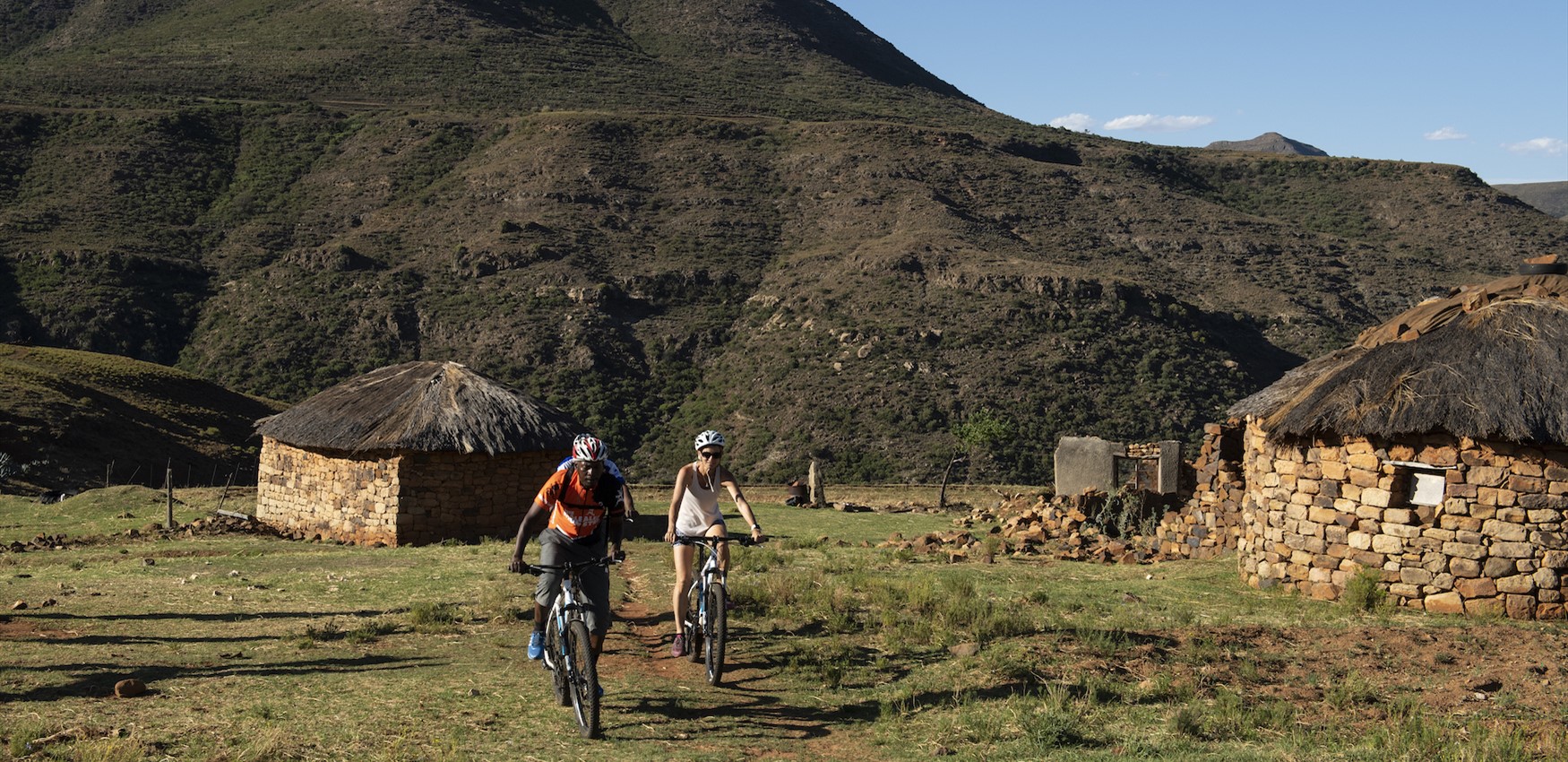
Lesotho is a fantastic destination for outdoor enthusiasts. Often referred to as the “Switzerland of Africa”, it offers a superb array of hiking, mountaineering, pony trekking, skiing, abseiling, birdwatching, boating and fishing opportunities in a gorgeous highland setting where burnished sandstone escarpments stand sentinel over undulating green meadows scattered with colourful wildflowers.
One of the world’s most mountainous countries, Lesotho is a democratic kingdom that gained independence from Britain in 1966, prior to which it was called Basutoland. Lesotho is unique in several respects. It is the only nation in the world to lie entirely above the 1,000m contour (the kingdom’s lowest point is 1,388m) and the only independent state other than the cities of Monaco and the Vatican to be enclosed entirely within another country (namely, South Africa). One of three remaining monarchies in Africa, it is also the continent’s most culturally and linguistically homogenous state, with an astonishing 99.7 percent of the population identifying as Basotho and speaking the Sesotho tongue.



